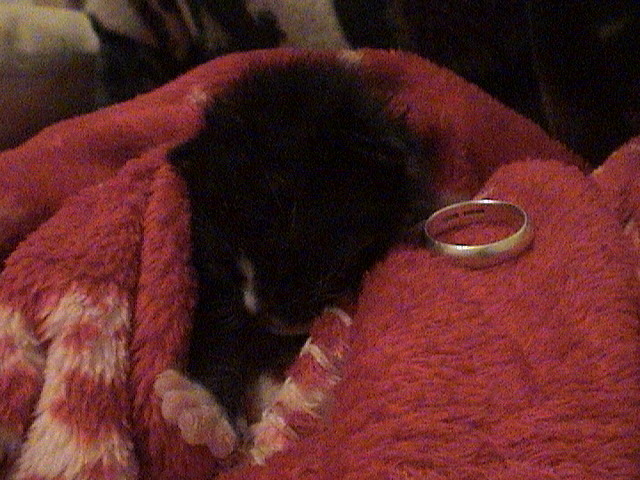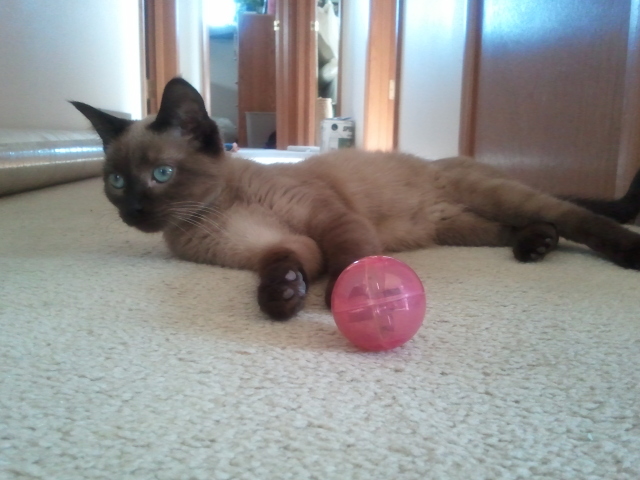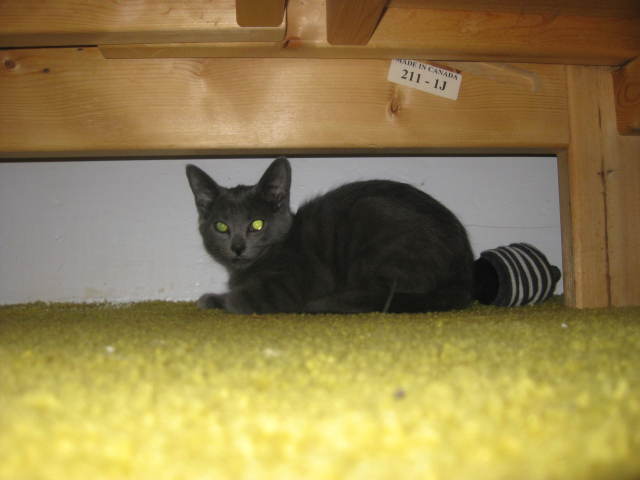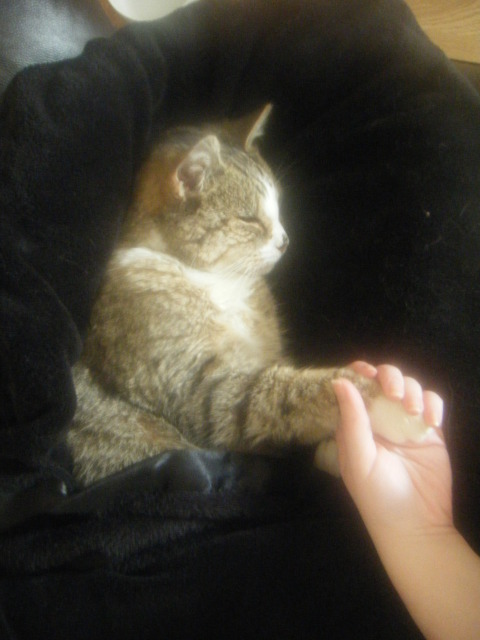QuestionQUESTION: Hi! We have three cats, two female and one male, all spayed/neutered. Recently we found another cat that we have taken in. We live on twenty acres in a rural area. We believe she was dropped off by someone, because people often do so on our dirt road. She was very sweet, and had no collar, we took her in. This was around two weeks ago. The problem is that she is having problems getting along with the other cats, and she seems to be most of the problem, growling and hissing as the other cats approach. She is very sweet with any people. My step-dad has said if her behavior doesn't improve, we will have to take her to the pound; which I don't want to happen especially considering it was almost closed down due to bad animal treatment. Is there any insight you can give to her behavior? Perhaps something that can be done to improve it? Thank you.
ANSWER: Chris,
New cat introductions can be complex issues and it's important to be aware of a few basic facts before you get started. Cats are very territorial and they don't like change much, this can sometimes lead to problems with fighting or fearful behavior on the part of one or both cats if introductions aren't done carefully, with the needs of your resident cat and newly adopted kitty in mind. Since you've already taken the important step of having each of your resident cats sterilized you've taken a huge step towards reducing their potential for territorial aggression. Cats that have been surgically sterilized tend to live longer, healthier lives, fewer behavioral problems and of course they don't contribute to the very serious pet overpopulation problem worldwide.
I typically recommend that new cat introductions take place in a very structured way. It's important to take the new cat/kitten's age, medical and vaccine status into consideration when introducing him/her to your resident cat. It's normally a good idea to isolate new additions to your household in a space of their own where they're unable to interact with resident cats for a minimum of 2-3 weeks. This isolation period serves a couple of purposes, firstly it allows for a quarantine period which will prevent your resident cat and newly adopted cat/kitten from spreading any contagious viral or bacterial infections to each other. It's very important to take your newly adopted family member to your family veterinarian and confirm that she's healthy and free of chronic and potentially serious viral infections like feline leukemia and FIV which are similar to HIV and AIDS in people (don't worry though, they can't pass these viral infections on to human beings). Some cats infected with FIV or feline leukemia can become quite sick while others go on to live fairly healthy, normal lives. The main reason that these viral infections are a concern is because there is a chance that cats living together in a multiple cat household can potentially pass these infections on to their housemates or other cats in the neighborhood if they're allowed outside. FIV and feline leukemia can be transmitted from cat to cat via contact with blood or saliva and in the case of outdoor cats, stray/feral cats that get into frequent fights with may have an increased risk of becoming infected.
The second purpose behind gradually introducing the new kitty after a quarantine period is to prevent any disputes over territory or any undesirable aggression due to the change in your household. New cats or kittens that lack confidence or are fearful may exhibit fear based or defensive aggression in the form of hissing or swatting at an unfamiliar adult cat when they haven't been properly introduced. After a 2-3 week isolation period and making sure to familiarize the resident cats with their newly adopted sister's scent and presence things should settle down significantly and there should be minimal risk of serious aggression between the newly adopted kitty and her resident feline companions.
I routinely use a safe, effective homeopathic remedy called Bach's Rescue Remedy which is a blend of flower essences designed to calm and reassure. In my opinion Rescue Remedy is a great tool to help cats in stressful situations. In this situation you could make use of this remedy to help ease your kitten's transition away from her mom and siblings and into your family. Rescue Remedy might be quite useful in this situation to help to keep your older cat as calm as possible throughout the potentially stressful introduction to his new little sister. I've used this remedy to tip the balance in my favor in tough situations as well as routine stuff like new cat introductions and I really believe that it's worth using as it's likely to help keep everyone as stress free as possible - this will help to ensure that the introduction process is as gentle and smooth as possible for all involved.
I normally suggest adding a dose of about 5-7 drops of Rescue Remedy to fresh bowls of water for each cat every morning and you can start that immediately. Rescue Remedy can be administered by rubbing a drop onto the relatively hair free area in front of your cats' ears, however it's important to make sure you don't get any inside of the ear canal because it can sting, especially if either kitty has an ear infection or scratches their ears frequently - the flower essences are preserved in a grape alcohol solution. Incidentally if either cat scratches their ears or shakes their head frequently it's well worth having your vet check to ensure that there aren't any ear mites present, these are tiny parasites that live in a pet's ear canal and they can be quite irritating for cats. If ear mites are present your vet will prescribe the appropriate treatment to kill the offending parasites.
You can often find Rescue Remedy in health food stores, naturopathic pharmacies, some mainstream pharmacies in the aisle with vitamins and nutritional supplements and I believe that you can also purchase this remedy online. Rescue Remedy is often used by pet parents and some veterinarians worldwide to treat injured, abused, traumatized, abandoned, anxious, fearful or timid animals and help them to recover from their special circumstances quite successfully. I have used Rescue Remedy in addition to TLC, patience and in some cases the use of conventional medical treatments for many years, it's worked some minor miracles in a variety of situations for cats and kittens that might not have otherwise coped with whatever rehabilitation they required.
In the unlikely event that a serious fight did break out it's very important not to get between fighting cats because cat scratches and bites can be serious and require medical attention because they can become infected. On the day of the first face to face meeting of the two cats I'd recommend having a water pistol/spray bottle, a heavy towel and a broom nearby just in case something goes drastically wrong during the introduction and a fight breaks out. Squirting the cats with the spray bottle might be enough to split up a mild fight. In the event that water doesn't stop the fighting a heavy towel can be tossed over one of the cats to stop them from striking out and they can be carefully separated that way although a broom can also be used to gently guide feuding felines apart so that no human body parts get between feuding kitties that way nobody gets hurt. If a bit of hissing and swatting happens I'd recommend supervising closely to ensure that nothing serious comes out of the posturing, if a fight breaks out then it's best to stop the introduction for that day, wait until everyone calms down and try the face to face introductions again in a few days.
In general the best way to start introducing the new cat/kitten to your resident cat in a gradual and non confrontational manner once everyone's healthy and ready for the introductions is to work with transferring scents back and forth between the two cats. You can do this by switching litter boxes, beds or toys, however it's best not to do those sorts of things until your newly adopted cat/kitten has been given a clean bill of health by your vet. Another way to accomplish the exchange of scents in a non-threatening way is to start off by rubbing the new arrival down with a hand towel, then rubbing the resident cats all over with the same towel and lastly going back to the kitten for a final rub down. This first step allows the resident cats and their new feline sister to gradually become accustomed to each other's unique scent and can minimize the risk of aggression between the two cats because they will be familiar with each other's scent. Scent provides a fair bit of information to a cat, for instance it can provide basic information about health, age, sex, reproductive status, illnesses, diet, etc. I'd recommend that you begin the towel scent exchanges as soon as possible and that you go through the entire process at least twice daily.
Another great tip to help get the cat and cat/kitten accustomed to one another is to feed them on either side of a closed door. For most cats food is a great motivator and you can accomplish incredible things by adding food rewards to the mix or simply having cats share mealtime in a safe, controlled manner. Feeding the cats on opposite sides of a closed door will help your new "siblings" to associate each others' scent with something positive - food. Often times resident cats and new additions will begin to show curiosity about each other and even play together under the door before they ever see each other. This is a great sign and should be encouraged. Play and food are wonderful tools to help facilitate a healthy relationship between the new cat and your resident cats as well as being an awesome way to strengthen the bond between you and your cats. Interactive toys like kitty teases and laser lights (do be careful to avoid shining the light into anyone's eyes as these toys can do damage) are great in terms of getting cats to play with you and each other. Special treats work well as a form of bribery to help an uncertain kitty become more comfortable with the presence of another cat in his/her territory. I find that cheese, chicken, fish or lamb work well and which foods you will need to use will depend upon what your cats prefer. If you have any further cat related questions or concerns, please don't hesitate to contact me again at any time - I'll be more than happy to help you in any way that I'm able to.
---------- FOLLOW-UP ----------
QUESTION: Thank you very much for such an in depth answer! We have been isolating her as you suggested, and after a couple introductions our other female cats sem to be getting along decently, albeit they are still wary, so we let her hang around the house with the other cats. So far all is well. One thing, though; all of our cats are fixed, but she is not, and we believe the new cat is going through heat. Is it bad to keep isolating her when in that state? Will it offset some behavioral balance? She and our male cat sit meowing and making other wierd noises through the door at eachother. And at any time they are together and the male cat tries to subdue or mount her we break them up, even though it's impossible for Buster (the male) to impregnate her. Is this bad as well?
AnswerChris,
It's best to keep the new unspayed arrival isolated because queens in season are fantastic escape artists and it only takes one escape to be left with a litter of unwanted kittens. My concern about Buster mounting your new queen is obviously that he knows that's what he's meant to be doing - I'm wondering if he was a mature neuter (done as an adult cat or a cat that had mated at least once before) or if he had an undescended testicle that the vet performing the surgery wasn't able to find easily that's just been hanging out there waiting for a chance to make kittens.
Personally I'd keep this little girl isolated until she has been given a clean bill of health by your veterinarian, she's received basic preventative care (like vaccines if blood tests show that she hasn't got sufficient immunity to protect herself against infections we normally vaccinate against) and she's been spayed - this way you don't have to worry so much about any unplanned pregnancies or accidental escapes. While I am well aware that a queen in season can be unbearable to live with keeping her isolated is really in everyone's best interests at this point, the sooner you have her spayed the sooner that your home will become MUCH quieter! If you wait any length of time to have this little girl spayed odds are pretty good that you'll have to bear with her cycling back into estrus every 2 weeks or so until she escapes from the house accidentally and comes home pregnant OR she's spayed so that she can no longer cycle.
It's not healthy for a queen to be allowed to cycle repeatedly without being mated so the sooner your girl can be spayed the better it will be for everyone's health and sanity. The reason that repeated estrus cycles can be problematic for pets is because the heat cycles create periods of time where the body produces increased amounts of sex hormones. When pets are repeatedly exposed to sex hormones there is a much greater chance that they will suffer from serious health issues that they may not have if they'd been spayed/neutered at an early age. Unaltered pets are at increased risk of developing mammary tumors, reproductive cancers or even a potentially lethal uterine infection called pyometra where the womb fills with pus and infected material. When a queen develops pyometra the reality is that she is usually critically ill before she's diagnosed and the only permanent cure for pyometra is to immediately have the queen spayed which is not quite the same as having a routine spay done on a healthy female cat or kitten because of the fact that a serious infection has compromised the queen's body and the surgery is much more complex and dangerous once a queen is in this state. Some queens don't survive pyometra even now with all of the advances in veterinary medicine because there's always the chance that the pressure inside the womb caused by the infected material taking up space will become too much and the womb will refuse to stretch any further which means that her womb would rupture spreading pus and infected material throughout the abdomen which carries a very poor prognosis in terms of the cat's survival. Usually pyometra occurs in older queens, but it's been known to happen in much younger queens of breeding age.
If you have any further questions or concerns, please don't hesitate to contact me again, I'd be more than happy to help you in any way that I can.

 Orphaned Kitten
QuestionQUESTION: My partner and l are very much animal
Orphaned Kitten
QuestionQUESTION: My partner and l are very much animal
 Litter Box Behaviour
Question
All Kitties
Hello!
Im writing to you fo
Litter Box Behaviour
Question
All Kitties
Hello!
Im writing to you fo
 Cinnamon, mysterious Siamese
Question
Cinnamon - mysterious
Hi, I picked you
Cinnamon, mysterious Siamese
Question
Cinnamon - mysterious
Hi, I picked you
 Shaking? Or is it from her purr?
Question
Prada Under our bed
We just adopted a Himalaya
Shaking? Or is it from her purr?
Question
Prada Under our bed
We just adopted a Himalaya
 my old cat with no appetite
Question
Timmy since his loss o
Hi, Im really worried a
my old cat with no appetite
Question
Timmy since his loss o
Hi, Im really worried a